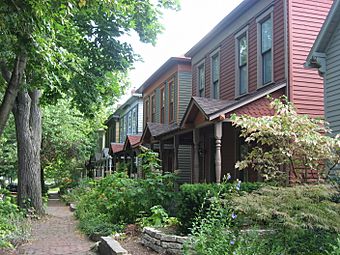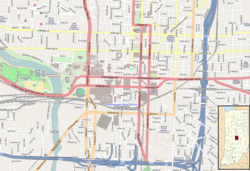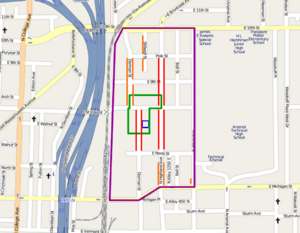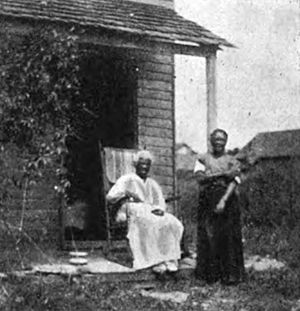Cottage Home Historic District facts for kids
Quick facts for kids |
|
|
Cottage Home Historic District
|
|

A view of the Cottage Home Historic District from Dorman Street. Historic homes and a historic sidewalk can be seen.
|
|
| Location | Bounded by CSX right-of-way (Dorman St) and 10th, Oriental, and Michigan Sts, Indianapolis, Indiana |
|---|---|
| Area | 2 acres (0.81 ha) (NRHP district) approx. 76 acres (31 ha) (state district) |
| Built | 1865-68 |
| Architect | Vonnegut & Bohn, et al. |
| Architectural style | Folk Victorian, Queen Anne |
| NRHP reference No. | 90000328 |
| Added to NRHP | February 23, 1990 |
The Cottage Home Historic District is a special neighborhood in Indianapolis, Indiana. It's known for its unique "cottage-style" homes. These houses have strong Victorian designs.
A small part of Cottage Home is listed on the National Register of Historic Places. This means it's officially recognized as important to history. A larger area is recognized at the state and local levels. Cottage Home was once a neighborhood where many working-class families lived.
After some tough times in the 1960s and 70s, the community worked hard to save its historic buildings. The neighborhood is now a lively and diverse place. The Cottage Home Neighborhood Association (CHNA) was formed in 1984. Their efforts helped stop homes from being torn down. People also became more interested in restoring the old houses.
The Ruskaup-Ratcliffe house and store are very important buildings. They helped the district get added to the National Register in 1990. The neighborhood's recognized area grew even more in 1995. In 2008, it became a Conservation District. This helps protect its unique character.
Contents
Where is Cottage Home?
Cottage Home is located on the east side of Indianapolis. It borders other interesting neighborhoods. To the west is the Chatham Arch & Massachusetts Avenue Historic District. To the north is Windsor Park. Arsenal Technical High School and Woodruff Place Historic District are to the east. The Holy Cross neighborhood is to the south.
Most of the neighborhood is laid out in a traditional grid plan. This means streets cross each other at right angles. However, Pogue's Run, a small stream, cuts through the southeast part.
National Register Boundaries
The original boundaries for the Cottage Home Historic District were smaller. These are still the current boundaries for the National Register district. This area includes 23 properties. It features the Ruskaup-Ratcliffe house and store. It also has homes designed by Vonnegut & Bohn. This smaller area was added to the National Register of Historic Places in 1990.
State and Local Boundaries
Cottage Home received a special state recognition in 1995. This expanded its historic district boundaries. In 2008, it became a local Conservation District. This followed the same larger boundaries as the state listing.
The Cottage Home Conservation District is bordered by a CSX train track. It's also bordered by 10th Street to the north. Oriental Street is to the east, and Michigan Street to the south. This larger area includes 320 land parcels and 292 buildings. More than half of these are homes.
A Look at Cottage Home's Past
Before it became a neighborhood, Cottage Home was part of two farms. These farms belonged to important people in Indiana. One farm was owned by Noah Noble, who was Indiana's fifth governor. The other belonged to Robert Hanna, a U.S. Senator.
When the railroad came to Indianapolis in 1847, the city grew quickly. By the end of the Civil War, an arsenal was built nearby. This arsenal later became Arsenal Technical High School. Streetcars also reached the area. This made it easy for residents to get to jobs. The farms were divided into lots for homes in 1865 and 1868. The area officially became part of Indianapolis in 1870.
After this, Cottage Home grew a lot. By 1900, nearly 400 families lived there. Most of these homes were rented. Many early residents were immigrant families or African Americans. One famous early resident was Louisa Magruder. Her father, Tom Magruder, was a slave of Governor Noble. He is believed to be the inspiration for Uncle Tom's Cabin.
The neighborhood also saw growth in businesses and factories. This was because it was close to the railroad and streetcar lines. By 1915, most of the building had finished. The unique look of the area was set.
In the 1960s and 70s, many people moved from inner-city neighborhoods to the suburbs. Cottage Home was also in a flood zone near Pogue's Run. This caused some residents to leave. Also, the building of I-70 and I-65 highways meant some homes were torn down. By the 1980s, over 100 houses in Cottage Home were gone.
But things changed! People became interested in restoring old homes. The Cottage Home Neighborhood Association (CHNA) started in 1984. These efforts stopped homes from being torn down. Since then, only a few homes have been lost. CHNA led the effort to get the neighborhood recognized as a historic district. This happened in 1990 (National Register), 1995 (State Register), and 2008 (city designation). Today, Cottage Home is still a lively and active community.
Cottage Home's Architecture
Cottage Home gets its name from a part of the neighborhood. It's also named after the main style of houses found there. These are Queen Anne and Folk Victorian-style cottages. Almost all the old homes fit these styles.
A special exception is the Ruskaup-Ratcliffe house. It mixes Romanesque Revival features with Queen Anne style. Businesses and factories in the area were often built in the Italianate or Art Deco styles. This depended on when they were built.
Homes in Cottage Home often have fancy porches with turned posts. They also have gable ornaments and varied shingles. These details are common in Queen Anne and Folk Victorian homes. They were an inexpensive way to make simple homes look unique. This was popular in working-class neighborhoods like Cottage Home during the Victorian era.
Special Features of Cottage Home
Cottage Home was a working-class neighborhood. So, most of its homes are modest in design. The Ruskaup-Ratcliffe house is a notable exception. But the neighborhood's rich history makes it very important. Here are some of the most interesting places and features in Cottage Home.
Ruskaup-Ratcliffe House and Store
The Ruskaup-Ratcliffe House and Store are the most important buildings for architecture in Cottage Home. Frederick Ruskaup, a German immigrant, built both. He came to the United States in 1869. By 1875, he bought land on Dorman Street. He opened a grocery store at 713 Dorman Street. His family lived upstairs. In 1885, he added more space to the store.
His successful grocery store and other rental properties allowed him to do something special. In 1892, Ruskaup hired a famous Indianapolis architecture firm, Vonnegut & Bohn. They designed a house for his family next door at 711 Dorman Street. Ruskaup's family lived in the house and ran the store until 1957. The properties were sold again in the 1980s. The house has been restored, and the store's front has been improved.
The Ruskaup grocery store was built in the Italianate style. This was a common style for buildings in the Midwest in the 1870s. It has attic windows and decorative brackets. These details make the store look special.
The architects combined Romanesque Revival details with Queen Anne architecture for the Ruskaup-Ratcliffe House. This created a very unique style. Romanesque Revival was popular with German immigrants like Frederick Ruskaup. Vonnegut & Bohn, who were also German-American, used German influences in their designs. Their later famous work, the Athenæum (Das Deutsche Haus), shows this.
The house has an uneven front with a porch that wraps around. It also has a tower, which are Queen Anne features. The Romanesque Revival style shows in the different window sizes. It also appears in the stone details and a stepped front gable. The inside of the house is also amazing. It has inlaid floors and special designs above doorways. These were common in Vonnegut & Bohn designs. Sadly, the original stained glass windows were removed in the early 1980s.
Vonnegut & Bohn Doubles, 702-720 Dorman Street
Another important part of Cottage Home's history is the Vonnegut & Bohn Doubles. These are a series of duplexes, or two-family homes. Frederick Ruskaup built them as rental properties in 1888. Most of these duplexes and two cottages burned down in 1890. Ruskaup quickly rebuilt them. He even added brick fire walls to some of them.
The same architecture firm, Vonnegut & Bohn, designed these houses. However, these duplexes look more like the common Italianate style. They have balanced fronts and hipped roofs. They also have full-length porches with spindlework. These features are common in the Queen Anne style.
The Vonnegut & Bohn Doubles are also special because they are the oldest homes in Indianapolis designed by this famous firm.
Dorman Street Saloon, 901 Dorman Street
The Dorman Street Saloon might look simple, but it has been very important to Cottage Home residents. This building started as a house in the early 1870s. In the 1910s, it was a grocery store. Later, it became a bar. After Prohibition ended, it was known by different names. It has always been a popular meeting place for the neighborhood. There's even a rumor that the famous criminal John Dillinger visited the Dorman Street Saloon. He supposedly stopped there before robbing a bank nearby.
Kroger Grocery & Bakery Company Building
The Kroger Grocery & Bakery Company Building is the largest building in Cottage Home. It covers 200,000 square feet (19,000 m2). In 1929, the growing Kroger Grocery & Bakery Company built this large warehouse. It helped them meet the needs of their Indianapolis stores. This Art Deco industrial building has large windows and pilasters. Today, the building is home to Marian, Inc. It is also often used for meetings by the Cottage Home Neighborhood Association.
Historic Sidewalks and Curbs
When Cottage Home was built, its streets had high-quality brick sidewalks and limestone curbs. Today, some of these sidewalks and curbs still remain. The neighborhood values them as important parts of its history. You can still find brick sidewalks on parts of Highland Avenue and Dorman Street. This includes the area in front of the Ruskaup-Ratcliffe house and store. Stone curbs are also still present on parts of Highland Avenue, Dorman Street, Stillwell Street, and Oriental Street.
Community Life
The Cottage Home Neighborhood Association holds an annual block party. They have done this since 1984. This party has even been named the best block party in Indianapolis several times! Cottage Home also works with the Near East Side Community Organization (NESCO). This group helps neighborhoods and non-profit organizations in the area. Kids living in Cottage Home attend schools like Washington Irving Elementary, Emma Donnan Middle School, and Arsenal Technical High School.








